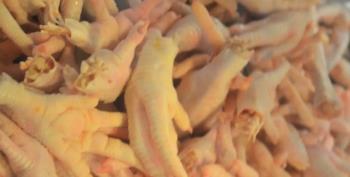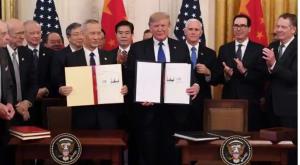Date released by the USDA-FAS indicated that China purchased chicken products attaining 99,875 metric tons during the first four months of 2020. Product was valued at $143.9 million representing an average unit price of $694 per metric ton compared to an average unit value of $1,028 per metric ton for the total of 1,176,851 metric tons. During the first quarter of 2020 exports to China were  constrained by disruptions associated with COVID-19. In April 2020, China imported 53,562 metric tons of chicken products valued at $73.3 million with a unit price of $1,368 per metric ton suggesting a change in composition of products, favoring feet. In April, purchases by China represented 18.6 percent of volume and 25 percent of value. Although second-ranked among importers in April 2020, exports to China exceeded the volume leader, Mexico by $25.6 million or 53.7 percent of the value shipped to Mexico during that month.
constrained by disruptions associated with COVID-19. In April 2020, China imported 53,562 metric tons of chicken products valued at $73.3 million with a unit price of $1,368 per metric ton suggesting a change in composition of products, favoring feet. In April, purchases by China represented 18.6 percent of volume and 25 percent of value. Although second-ranked among importers in April 2020, exports to China exceeded the volume leader, Mexico by $25.6 million or 53.7 percent of the value shipped to Mexico during that month.
Given the potential importance of China to the U.S. chicken industry, it is important to understand their motivation to buy our products and to understand the broader issues that influence trade between China and the U.S.
 China buys U.S. chicken mainly based on the criteria of need and price. At the present time, China has yet to rebuild breeding and growing herds seriously depleted by African swine fever. In the absence of an effective vaccine, China will not be able to restructure their industry to allowing for integration, efficiency and restoration of volume. The production of white-feathered broilers required for the domestic quick-service industry as favored by younger consumers was seriously constrained by embargoes on grandparent stock imposed in 2015 due to internal strategic considerations. The broiler industry in China has yet to achieve its potential, but domestic production is growing, with long-term implications for imports from the U.S. and Brazil.
China buys U.S. chicken mainly based on the criteria of need and price. At the present time, China has yet to rebuild breeding and growing herds seriously depleted by African swine fever. In the absence of an effective vaccine, China will not be able to restructure their industry to allowing for integration, efficiency and restoration of volume. The production of white-feathered broilers required for the domestic quick-service industry as favored by younger consumers was seriously constrained by embargoes on grandparent stock imposed in 2015 due to internal strategic considerations. The broiler industry in China has yet to achieve its potential, but domestic production is growing, with long-term implications for imports from the U.S. and Brazil.
All decisions made by the central Government must be evaluated in the context of nationalism. The Communist party has consistently used pride and aspiration as a means to entrench support and to deflect criticism directed at corruption, mismanagement and degradation of the environment. China is always ready to use coercive trade tactics to achieve commercial benefits. Applying asymmetric pressure, China has at times banned importation of bananas from the Philippines, imposed restrictive duties on canola imports from Canada and cancelled beef imports from Australia all as leverage to achieve political and diplomatic objectives.
In terms of the Phase One Trade Agreement with the U.S., signed in mid-January, China agreed to purchase large quantities of U.S. agricultural commodities presumably including chicken. The unjustified 2015 ban on U.S. poultry products extending from breeding stock through to chicken portions and feet was rescinded, potentially allowing imports from the U.S. that have materialized. When convenient to China, phyto-sanitary considerations will be implicated as a "justification" to disrupt trade and inflict pain on U.S. producers in order to protect their domestic industry or to create a bargaining position.
During the late 1990's, the U.S. chicken industry rode a wave of export volume based on Bush Legs exported to Russia. When it suited that nation, trade was constrained by artificial and frequently spurious embargoes implicating Salmonella contamination, drug residues and in one instance, alleged detection of radioactivity in product. As with Russia, the leadership of China is willing to use trade as a political weapon and has no compunction in imposing restrictions on their domestic population to achieve leverage with trading partners. If we are to continue trading with China we should be aware of the aphorism that to sup with the Devil one should use a spoon with a long handle.